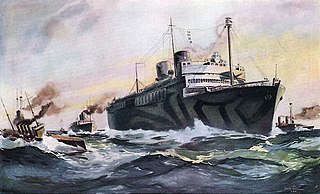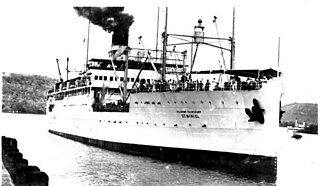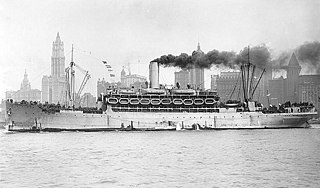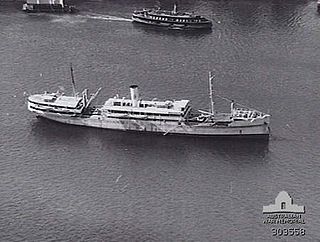
USS Comfort (AH-3) was a hospital ship for the United States Navy in World War I. She was the sister ship of USS Mercy (AH-4) but the two ships were not of a ship class. Comfort was known as SS Havana in passenger service for the Ward Line, and as USAT Havana in United States Army service before her Navy service. Her name was restored to Havana in 1927, and she was renamed SS Yucatán in 1935, and SS Agwileon in 1941. In World War II, she was known as USAT Agwileon and USAHS Shamrock in service for the United States Army.

SS Borinquen, the Taino language name for Puerto Rico, was a passenger liner launched 24 September 1930 and delivered to the Atlantic, Gulf & West Indies Steamship Lines (AGWI) in 1931 for operation by its subsidiary the New York & Porto Rico Line. The line operated the ship until it was requisitioned by the War Shipping Administration (WSA) the last day of 1941 for service as a troop transport. The line then operated the ship as agent for the WSA until 6 May 1944 when operation was transferred to the United States Army for support of the Normandy landings with the ship arriving off the beaches on 7 June 1944. Borinquen continued service post war until redelivered to the owners 14 June 1946. The ship was sold in 1949 and became the Arosa Star. After further sales and change in the cruise ship regulations the ship was again sold and grounded as La Jenelle on the California coast in 1970.

The New York Port of Embarkation (NYPOE) was a United States Army command responsible for the movement of troops and supplies from the United States to overseas commands. The command had facilities in New York and New Jersey, roughly covering the extent of today's Port of New York and New Jersey, as well as ports in other cities as sub-ports under its direct command. During World War I, when it was originally known as the Hoboken Port of Embarkation with headquarters in seized Hamburg America Line facilities in Hoboken, New Jersey, the Quartermaster Corps had responsibility. The sub-ports were at Boston, Baltimore, Philadelphia and the Canadian ports of Halifax, Montreal and St. Johns. The World War I port of embarkation was disestablished, seized and requisitioned facilities returned or sold and operations consolidated at the new army terminal in Brooklyn. Between the wars reduced operations continued the core concepts of a port of embarkation and as the home port of Atlantic army ships. With war in Europe the army revived the formal New York Port of Embarkation command with the New York port, the only Atlantic port of embarkation, taking a lead in developing concepts for operations.

USS Siboney (ID-2999) was a ship transport for the United States Navy during World War I. She was the sister ship of USS Orizaba (ID-1536) but neither was part of a ship class. Launched as SS Oriente, she was soon renamed after Siboney, Cuba, a landing site of United States forces during the Spanish–American War. After her navy service ended, she was SS Siboney for the New York & Cuba Mail Steamship Co.. The ship was operated under charter by American Export Lines beginning in late 1940. During World War II she served the U.S. Army as transport USAT Siboney and as hospital ship USAHS Charles A. Stafford.

USS Samaritan (AH-10) was a hospital ship that served with the US Navy in World War II. Prior to that, she served as a US Navy transport ship under the name USS Chaumont (AP-5).

USS Wharton (AP-7) was a troop transport in the service of the United States Navy during World War II. The ship was originally an Emergency Fleet Corporation Design 1029 type built for the United States Shipping Board. The ship was laid down as Manmasco but renamed and launched as Sea Girt then completed September 1921 as Southern Cross. The ship was first allocated by the United States Shipping Board to the Munson Steamship Line until purchased by the line in 1925. Munson operated the Southern Cross in the South American trade from 1921 until 1938 when the ship was sold at a Marshall's sale and taken over by the United States Maritime Commission which paid the full mortgage claim.

SS Munargo was a commercial cargo and passenger ship built for the Munson Steamship Line by New York Shipbuilding Corp., Camden, New Jersey launched 17 September 1921. Munargo operated for the line in the New York-Bahamas-Cuba-Miami service passenger cargo trade. In June 1930 the United States and Mexican soccer teams took passage aboard Munargo from New York to Uruguay for the 1930 FIFA World Cup. The ship was acquired by the War Shipping Administration and immediately purchased by the War Department for service as a troop carrier during World War II. Shortly after acquisition the War Department transferred the ship to the U.S. Navy which commissioned the ship USS Munargo (AP-20). She operated in the Atlantic Ocean for the Navy until returned to the War Department in 1943 for conversion into the Hospital ship USAHS Thistle.

St. Mihiel was a troopship built for the United States Shipping Board by the American International Shipbuilding Corporation at Hog Island, Pennsylvania. The ship was operated from 1922 until mid-1940 as USAT St. Mihiel by the Army Transport Service. In July 1941 the ship was transferred to the Navy which commissioned her USS St. Mihiel with the hull number AP-32. In November 1943, she was transferred back to the Army and converted into the hospital ship, USAHS St. Mihiel.

John L. Clem was built as the cargo and passenger liner Santa Ana for W. R. Grace and Company for service in Grace Line's South American service but was requisitioned before completion by the United States Shipping Board (USSB) in 1918 due to World War I. The ship was chartered back to Grace after completion until turned over to the United States Navy to be briefly commissioned as the troop transport USS Santa Ana (ID-2869) from 11 February 1919 to 21 July 1919.

Koninklijke Paketvaart-Maatschappij, better known as KPM, was a Dutch shipping company (1888–1966) in the Netherlands East Indies, now Indonesia. It was the dominant inter-island shipping line in Indonesia during the last half century of the colonial era.

USS Antaeus (AS-21/AG-67) was a commercial passenger liner that the United States Navy acquired in World War II. She was SS Saint John from 1932 until 1941 before she the US Navy acquired her and commissioned her as Antaeus. From 1941 to 1943, she was a submarine tender; she was later redesignated AG-67 and used as a troop transport from 1943 to 1944. In 1945, she was converted to a hospital ship, renamed USS Rescue (AH-18), and served in the Pacific War. Decommissioned in 1946, she was sold for scrap in 1958.

SS Tasman was a 4,922 gross register tons (GRT) Dutch steamship built by Earle's Shipbuilding and Engineering Company Limited, Hull in 1921 for Koninklijke Paketvaart-Maatschappij (KPM), Batavia. With outbreak of the war in the Pacific and the fall of the Dutch East Indies, Tasman was one of 21 KPM vessels that sought refuge in Australia. These ships became the core of the initial Southwest Pacific Area (SWPA) command's permanent local fleet under U.S. Army control. After general service as a transport, the ship was converted to a hospital ship at Melbourne. The ship, under the Dutch flag and Dutch certification under the Hague Convention, served the remainder of the war as a Dutch hospital ship.

USAHS Marigold was a United States Army hospital ship during World War II. The ship was built as Old North State in 1920 for the United States Shipping Board as a civilian passenger/cargo liner. The ship changed ownership and operating companies several times with name changes to President Van Buren and President Fillmore before being acquired for military transport service in 1941. After government acquisition during World War II President Fillmore served as a War Shipping Administration troop transport before conversion to hospital ship service.

SS Mactan was launched 28 December 1898 as the passenger/cargo ship North Lyell for North Mount Lyell Copper Co.Ltd. intended for service between the west coast of Tasmania and Melbourne. The company no longer needed the ship on delivery in 1899 with resulting sale to Union Steamship Company of New Zealand Ltd. and renaming as Moura. In 1915 upon sale to the Douglas Steamship Company, Ltd. of Hong Kong she was renamed Hai Hong. Upon sale to Philippine operators in 1928 the ship gained the final name Mactan.
SS Haiti was a passenger and freight ship built for the Colombian Mail Steamship Company built at Newport News Shipbuilding, Newport News, Virginia and delivered 15 December 1932. The ship was renamed briefly Puerto Rico in 1938 and Monterey in 1939 to operate for the New York and Cuba Mail Steamship Company until requisitioned with transfer of title to the War Shipping Administration (WSA) on 25 September 1942. The ship was then allocated to the U.S. Army for operation under a bareboat agreement as USAT Monterey. In 1943 the ship was assigned to the command at Trinidad to supply bases in Brazil and Ascension Island. After layup in the reserve fleet the ship was sold to Turkey.

The Charleston Port of Embarkation (CPOE) was a United States Army Port of Embarkation (POE) responsible for the movement of troops and supplies from the United States to overseas commands. The CPOE was established in Charleston to relieve pressure on the New York Port of Embarkation with initial responsibility largely centered on the West Indies and Caribbean. After the United States entered the war Charleston became a POE in its own right. Later in the war, more use was be made of the Port, and it was designated as the home port for Army hospital ships serving the European and Mediterranean theaters. In the spring of 1943 the Chief of Transportation began to train personnel for the operation and maintenance of small boats and amphibian trucks there, before they were moved to Camp Gordon Johnston. The CPOE also served as a training place for army beach landings.

MV Saturnia was an Italian ocean liner named after Saturnia, Tuscany, the first of two sister ships built in Trieste for Cosulich Soc. Triestina di Nav. of Trieste and launched in 1925. Sister ship MS Vulcania was launched the next year. Saturnia served into World War II for Italy and upon the Italian armistice with the Allies was delivered to the U.S. War Shipping Administration (WSA) in an arrangement made between Italy and Admiral Cunningham of the Royal Navy, approved by General Eisenhower.

Allied logistics in the Southern France campaign played a key role in the success of Operation Dragoon, the Allied invasion of southern France during World War II. The campaign officially commenced with the US Seventh Army landings on the French Riviera on 15 August 1944. On 12 September, the Seventh Army made contact with Allied forces that had landed in Normandy earlier that year as part of Operation Overlord. The supporting logistical organizations continued to operate separately, with the Southern Line of Communications supporting the Seventh Army drawing its supplies from the North African Theater of Operations until it merged with the Communications Zone of the European Theater of Operations on 20 November.


















